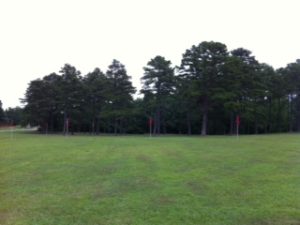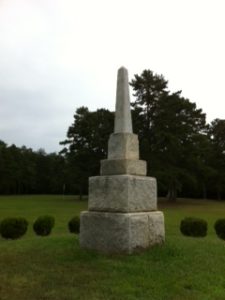- “Hold, doctor! Go away yourself, or Tryon’s men will kill you in three minutes!”
On May 16, 1771, Patrick Mullins spoke these words as he interrupted a final plea for peace by Rev. David Caldwell. Caldwell was speaking to armed Piedmont farmers who had gathered near Alamance Creek, a community in the north-central part of North Carolina, to confront the Royal Governor William Tryon and his troops. Rev. Caldwell left the field, and minutes later the Battle of Alamance began.

Photos by Wells Martin III
Leading Up To Battle
In the 1760s, local sheriffs and other officials of inland North Carolina were exploiting the Piedmont farmers by collecting and pocketing excessive taxes. A resistance movement arose, called the Regulator movement. The movement became progressively more menacing. In 1771, the Royal Governor of North Carolina, William Tryon, decided to confront the Regulators to end their threatened insurrection. He gathered an armed force of 2,000-3,000 loyalist North Carolina colonists and marched to the Piedmont.
Eyewitness accounts documented Patrick Mullins’ role in an 1842 biography of Rev. David Caldwell. In the early morning of May 16, Patrick Mullins was serving as the scout for the 1,000 gathered Regulators. He spotted Tryon’s men on the march and rode breathlessly into the Regulator camp with the news that Tryon was advancing fast. As the Regulators prepared their defensive positions, Patrick was observed to reprimand a group of young Regulators who were wrestling and not paying attention to the serious business at hand.
With the quote above, Patrick ended the last attempt to prevent shooting. Amazingly, Patrick was 67 during the Battle of Alamance. He is called “Patrick Mullins, an old Scotchman…” in the Caldwell biography.

The First Battle Of The Revolution
The Battle of Alamance lasted about two-and-a-half hours. As the battle raged, Governor Tryon sent a flagman forward to negotiate an end to the fighting. Patrick, who had served in the British Army as a youth in Scotland, understood the flagman’s mission and shouted to his fellow Regulators: “It’s a flag, don’t shoot!” His entreaty was in vain: the flagman was shot dead. As the morning wore on, the Regulators ran out of ammunition and fled the field. Dozens of men were killed on both sides.
Although this 1771 insurrection was quelled, the Battle of Alamance is sometimes called the first battle of the Revolution. Patrick Mullins survived and lived to fight in the Revolution—one of his 1782 pay vouchers survives.

Alamance Battleground State Historic Park
Patrick survived the Battle of Alamance and the Revolutionary War. He was still alive in 1790 when he appeared in the U.S. Census in Rockingham County, North Carolina.
We do not know if Patrick’s son and the next in the Mullins lineage, Rev. Thomas Mullins, was present at the Battle of Alamance. Rev. Mullins did join his father in service in the Continental Army during the American Revolution.
See the biography of Patrick Mullins for more about this Scot’s life, and proof of lineage for our family’s membership in the Society of Colonial Wars. Check out the biography of Patrick’s son, Rev. Thomas Mullins, and his Revolutionary War service that qualified our family for membership in the Sons of the American Revolution.
© 2013 W. Mullins
